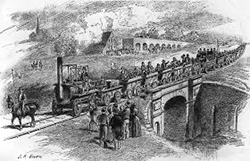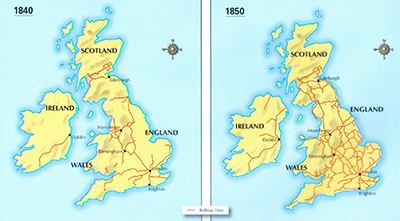A Brief History of the Railways in the United Kingdom
Railways in the United Kingdom became popular in the mid-19th Century, after modest beginnings, and now crisscross the four countries. 
The most dynamic innovation in transportation during the Industrial Revolution was the railroad. The adoption of new methods to produce more and cheaper iron led to the increased production possibility of iron rails used as tracks by the steam locomotives that pulled the railway carriages of the 19th Century. Richard Trevithick it was in 1802 who built the first steam-powered locomotive, advertising it by driving it down the streets of Camborne in Cornwall. That one didn't have a name. The first commercially successful one did: It was Salamanca, done by John Blenkinsop and Matthew Murray, and it ran for the first time in 1812. Another of the important railway engineers was George Stephenson, whose first locomotive rans in the 1810s. The first public railway, the Stockton and Darlington Railway, As construction was going on at a breakneck pace, security and safety sometimes took a back seat. Established in 1840 was the Railway Inspectorate, with investigators assigned to conduct inquiries into known crashes and derailments and others tasked with crafting safety standards for the booming network. Transport executives also struggled at times to get their goods or passengers on trips of long distances because the lack of a standard gauge meant what many considered unnecessary train changes. George Stephenson, who built the Liverpool and Manchester Railway using a rail gauge of 4 feet, 8.5 inches. The Great Western Railway, built by Isambard King Brunel, used a much wider rail gauge of 7.25 inches. Parliament in 1946 passed the Gauge of Railways Act, choosing Stephenson's narrower gauge to be the national standard. It took several more years, but the standard finally took hold. (The Great Western continued to be the one exception.) Eventually, rail lines stretched from southernmost England to the northern reaches of Scotland, from the closes point in East Anglia to the westernmost parts of Wales. The various companies competed to improve passenger numbers and cut transport times. Electricity came into the picture toward the end of the 19th Century, replacing coal and steam as a power source. Brighton in 1883 was the first to go "online." Another innovation came in 1902, with the first automatic signals, between Andover and Grateley. Into the 20th Century, amalgamation became the name of the enterprise. The Railways Act 1921 created the Big Four of the Great Western Railway; the London, Midland and Scottish Railway; the London and North Eastern Railway; and the Southern Railway. And in 1947, the Transport Act nationalized them all into British Railways. All of this, of course, involved railway travel above ground. It was in 1863 that the London Underground opened. |
|
Social Studies for Kids
copyright 2002–2026
David White



 with Stephenson as its engineer, opened in 1825. The Liverpool and Manchester Railway opened in 1830; it was the first inter-city railway in the world. Others quickly followed, including the Grand Junction and the London and Birmingham. Construction of railway lines was very high in the 1840s, so much so that by the end of the decade, railways covered most of the country. In four years of concentrated spending and activity in the 1830s and 1840s, Parliament authorized 8,000 miles of railroad lines that cost what some historians assert was the value of the entire Gross Domestic Product.
with Stephenson as its engineer, opened in 1825. The Liverpool and Manchester Railway opened in 1830; it was the first inter-city railway in the world. Others quickly followed, including the Grand Junction and the London and Birmingham. Construction of railway lines was very high in the 1840s, so much so that by the end of the decade, railways covered most of the country. In four years of concentrated spending and activity in the 1830s and 1840s, Parliament authorized 8,000 miles of railroad lines that cost what some historians assert was the value of the entire Gross Domestic Product.
